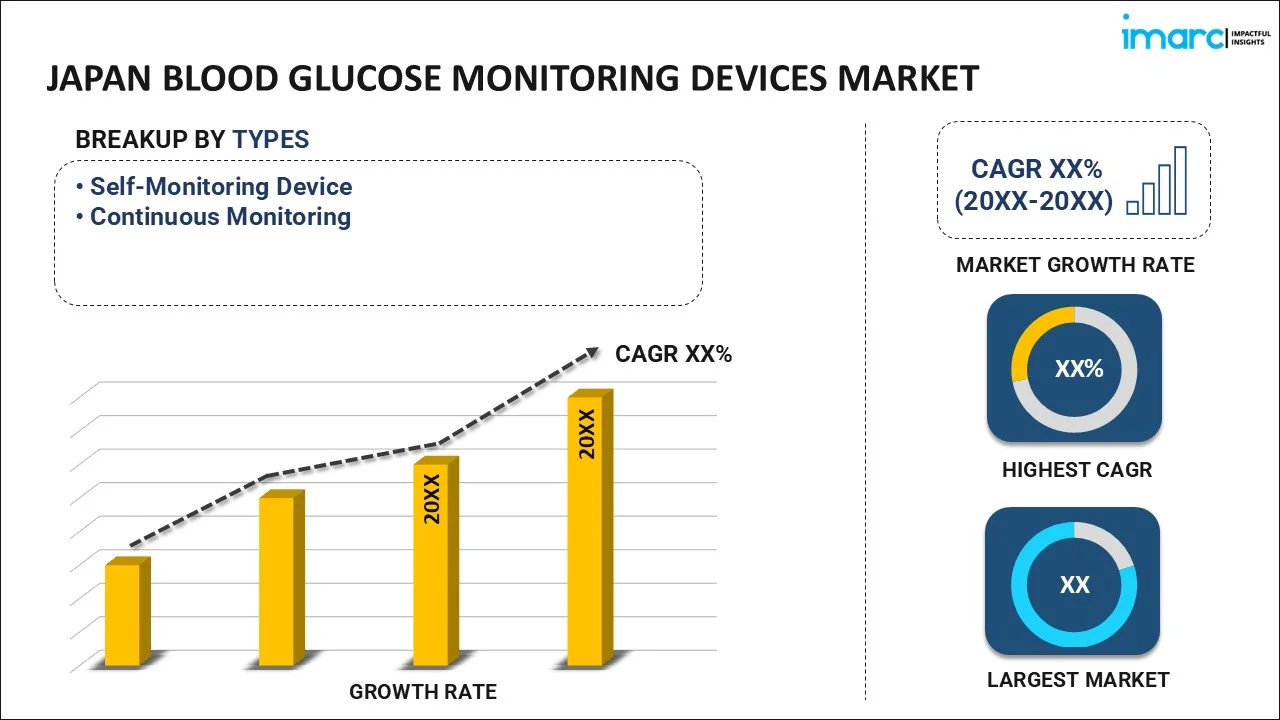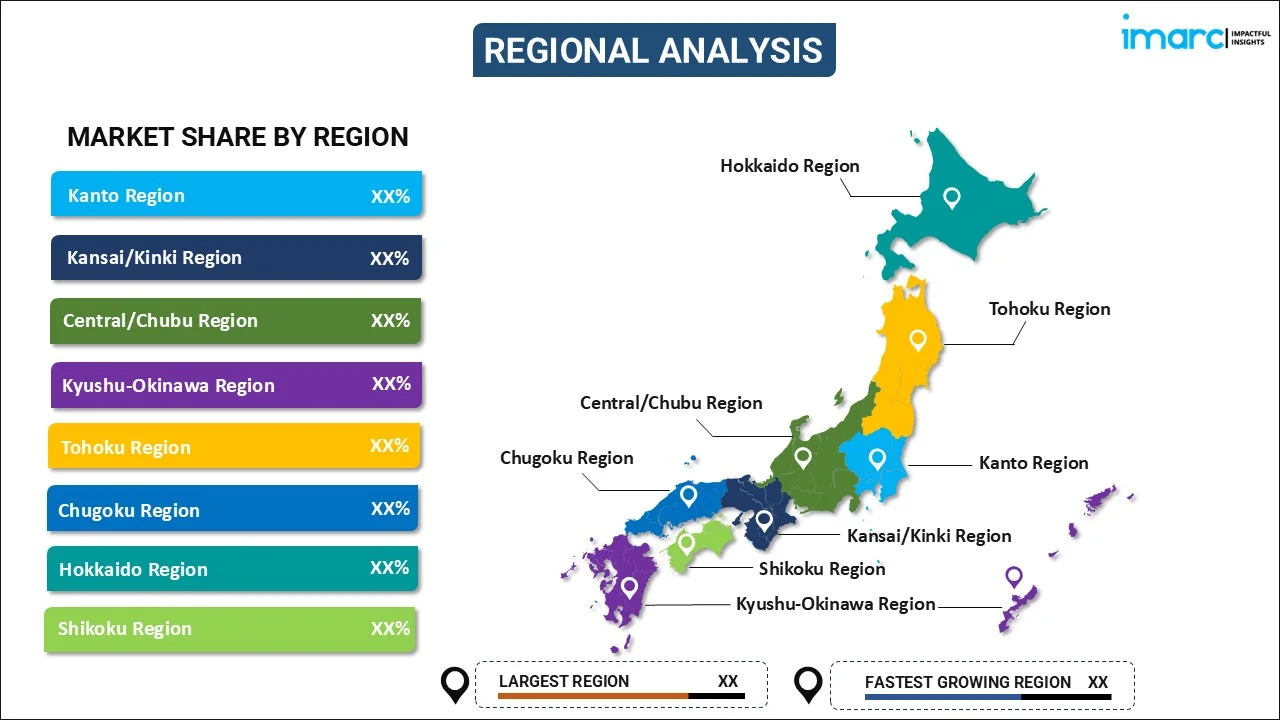
Japan Blood Glucose Monitoring Devices Market Size, Share, Trends and Forecast by Type, Testing Site, Application, End User and Region, 2025-2033
Japan blood glucose monitoring devices Market Overview:
The Japan blood glucose monitoring devices market size reached USD 939.25 Million in 2024. Looking forward, IMARC Group expects the market to reach USD 2,091.04 Million by 2033, exhibiting a growth rate (CAGR) of 8.60% during 2025-2033. The Japan blood glucose monitoring devices market is growing due to rising diabetes prevalence, technological advancements in wearable devices, and increasing healthcare awareness. Additionally, government initiatives promoting healthcare access and rising demand for home-based monitoring solutions are primary factors of market growth.
|
Report Attribute
|
Key Statistics
|
|---|---|
|
Base Year
|
2024
|
|
Forecast Years
|
2025-2033
|
|
Historical Years
|
2019-2024
|
| Market Size in 2024 | USD 939.25 Million |
| Market Forecast in 2033 | USD 2,091.04 Million |
| Market Growth Rate (2025-2033) | 8.60% |
Japan Blood Glucose Monitoring Devices Market Trends:
Rising Demand for Innovative Monitoring Solutions
The Japanese market for blood glucose monitoring devices has grown significantly in recent years, driven by increased awareness of diabetes management and healthcare. Type 2 diabetes, in particular, is on the rise in Japan due to factors like lifestyle changes, aging, and genetics, leading to higher demand for advanced glucose meters and monitoring products. In response, companies are developing more precise, user-friendly, and personalized monitoring systems. Traditional glucose meters are being supplemented by continuous glucose monitoring systems, which provide real-time data and detailed insights into glucose levels throughout the day. These devices assist patients and healthcare providers in making timely decisions about insulin dosage, diet, and exercise, improving overall diabetes care. For example, Abbott and Dexcom have introduced advanced CGM technologies in Japan, offering users continuous data to help manage their glucose levels. Abbott’s FreeStyle Libre system, which uses a small sensor applied to the skin to track glucose levels, is particularly popular. These devices reduce the need for frequent finger-prick tests and help patients actively manage their diabetes. The shift toward continuous and accessible monitoring solutions is expected to continue driving innovation and competition in the market.
Government Support for Diabetes Care Advancements
The market for blood glucose monitoring devices has benefited from the government of Japan's active promotion of better diabetes care. The Japanese healthcare system is putting more focus on improving disease prevention, earlier identification, and practical management as a result of an aging population and an increase in diabetes incidence. Along with this, national health initiatives now include leading-edge glucose monitoring technologies. In addition, several types of diabetes management devices, including glucose meters and CGMs, are included under Japan's National Health Insurance plan, making it easier for patients to receive these necessary devices at an affordable cost. In line with these trends, government programs are heightening the demand for blood glucose monitoring devices designed to fight the country's diabetes epidemic. For example, the Japanese Ministry of Health, Labour, and Welfare has been promoting awareness campaigns and research funding on improved diabetes management practices. Encouraging the adoption of technology such as data-sharing platforms, glucose monitoring apps, and remote patient monitoring also focused on integrating digital health solutions into Japan's healthcare system. As such, these trends serve to underpin continued growth within the Japanese market for blood glucose monitoring, which is beneficial to both healthcare professionals and patients. Simultaneously, such regulations serve to ease access to resources that these patients need to administer effective diabetes therapy to make available advanced equipment for the medical field.
Japan Blood Glucose Monitoring Devices Market Segmentation:
IMARC Group provides an analysis of the key trends in each segment of the market, along with forecasts at the region/country level for 2025-2033. Our report has categorized the market based on type, testing site, application, and end user.
Type Insights:

- Self-Monitoring Device
- Continuous Monitoring
The report has provided a detailed breakup and analysis of the market based on the type. This includes self-monitoring device and continuous monitoring.
Testing Site Insights:
- Fingertip
- Upper Arm
- Forearm
- Others
A detailed breakup and analysis of the market based on the testing site have also been provided in the report. This includes fingertip, upper arm, forearm, and others.
Application Insights:
- Type 1 Diabetes
- Type 2 Diabetes
The report has provided a detailed breakup and analysis of the market based on the application. This includes type 1 diabetes and type 2 diabetes.
End User Insights:
- Hospitals
- Homecare
- Diagnostic Centres
- Ambulatory Surgical Centres
The report has provided a detailed breakup and analysis of the market based on the end user. This includes hospitals, homecare, diagnostic centres, and ambulatory surgical centres.
Regional Insights:

- Kanto Region
- Kansai/Kinki Region
- Central/ Chubu Region
- Kyushu-Okinawa Region
- Tohoku Region
- Chugoku Region
- Hokkaido Region
- Shikoku Region
The report has also provided a comprehensive analysis of all the major regional markets, which include Kanto Region, Kansai/Kinki Region, Central/ Chubu Region, Kyushu-Okinawa Region, Tohoku Region, Chugoku Region, Hokkaido Region, and Shikoku Region.
Competitive Landscape:
The market research report has also provided a comprehensive analysis of the competitive landscape. Competitive analysis such as market structure, key player positioning, top winning strategies, competitive dashboard, and company evaluation quadrant has been covered in the report. Also, detailed profiles of all major companies have been provided.
Japan Blood Glucose Monitoring Devices Market News:
- In August 2024, Sumitomo Pharma and Poxel announced positive results from a post-marketing study of TWYMEEG for type 2 diabetes with renal impairment in Japan. This development impact the Japan blood glucose monitoring device market by influencing treatment options, requiring enhanced monitoring devices for managing renal-compromised diabetes patients.
- In July 2024, Roche received CE Mark approval for its Accu-Chek SmartGuide CGM solution. This AI-enabled device offers predictive glucose management for type 1 and type 2 diabetes. Its launch in Japan is expected to advance the blood glucose monitoring market, enhancing patient care and therapy management.
Japan Blood Glucose Monitoring Devices Market Report Coverage:
| Report Features | Details |
|---|---|
| Base Year of the Analysis | 2024 |
| Historical Period | 2019-2024 |
| Forecast Period | 2025-2033 |
| Units | Million USD |
| Scope of the Report |
Exploration of Historical Trends and Market Outlook, Industry Catalysts and Challenges, Segment-Wise Historical and Future Market Assessment:
|
| Types Covered | Self-Monitoring Device and Continuous Monitoring |
| Testing Sites Covered | Fingertip, Upper Arm, Forearm, = Others |
| Applications Covered | Type 1 Diabetes, Type 2 Diabetes |
| End Users Covered | Hospitals, Homecare, Diagnostic Centres, Ambulatory Surgical Centres |
| Regions Covered | Kanto Region, Kansai/Kinki Region, Central/ Chubu Region, Kyushu-Okinawa Region, Tohoku Region, Chugoku Region, Hokkaido Region, Shikoku Region |
| Customization Scope | 10% Free Customization |
| Post-Sale Analyst Support | 10-12 Weeks |
| Delivery Format | PDF and Excel through Email (We can also provide the editable version of the report in PPT/Word format on special request) |
Key Questions Answered in This Report:
- How has the Japan blood glucose monitoring devices market performed so far and how will it perform in the coming years?
- What is the breakup of the Japan blood glucose monitoring devices market on the basis of type?
- What is the breakup of the Japan blood glucose monitoring devices market on the basis of testing site?
- What is the breakup of the Japan blood glucose monitoring devices market on the basis of application?
- What is the breakup of the Japan blood glucose monitoring devices market on the basis of end user?
- What are the various stages in the value chain of the Japan blood glucose monitoring devices market?
- What are the key driving factors and challenges in the Japan blood glucose monitoring devices market?
- What is the structure of the Japan blood glucose monitoring devices market and who are the key players?
- What is the degree of competition in the Japan blood glucose monitoring devices market?
Key Benefits for Stakeholders:
- IMARC’s industry report offers a comprehensive quantitative analysis of various market segments, historical and current market trends, market forecasts, and dynamics of the Japan blood glucose monitoring devices market from 2019-2033.
- The research report provides the latest information on the market drivers, challenges, and opportunities in the Japan blood glucose monitoring devices market.
- Porter's Five Forces analysis assist stakeholders in assessing the impact of new entrants, competitive rivalry, supplier power, buyer power, and the threat of substitution. It helps stakeholders to analyze the level of competition within the Japan blood glucose monitoring devices industry and its attractiveness.
- Competitive landscape allows stakeholders to understand their competitive environment and provides an insight into the current positions of key players in the market.
Need more help?
- Speak to our experienced analysts for insights on the current market scenarios.
- Include additional segments and countries to customize the report as per your requirement.
- Gain an unparalleled competitive advantage in your domain by understanding how to utilize the report and positively impacting your operations and revenue.
- For further assistance, please connect with our analysts.
 Inquire Before Buying
Inquire Before Buying
 Speak to an Analyst
Speak to an Analyst
 Request Brochure
Request Brochure
 Request Customization
Request Customization




.webp)




.webp)












